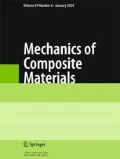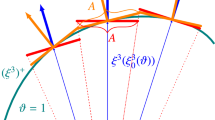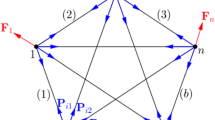An efficient method for solving three-dimensional elasticity problems for metal-ceramic composite shells is presented. According to this method, in the shell body, N sampling surfaces (SaS) parallel to its midsurface are chosen in order to introduce the displacement vectors of these surfaces as unknown functions. The SaS pass through the nodes of a Chebyshev polynomial, which improves the convergence of the SaS method significantly. As a result, this method can be applied to the derivation of such analytical solutions for metal-ceramic shells that asymptotically approach the exact three-dimensional solutions of elasticity as the number N of SaS tends to infinity.



Similar content being viewed by others
References
Z. Q. Cheng and R. C. Batra, “Three-dimensional thermoelastic deformations of a functionally graded elliptic plate,” Composites: Part B, 31, 97-106 (2000).
J. N. Reddy and Z. Q. Cheng, “Three-dimensional thermomechanical deformations of functionally graded rectangular plates,” Europ. J. Mech. A/Solids, 20, 841-855 (2001).
S. S. Vel and R. C. Batra, “Exact solution for thermoelastic deformations of functionally graded thick rectangular plates,” AIAA J., 40, 1421-1433 (2002).
J. L. Pelletier and S. S. Vel, “An exact solution for the steady-state thermoelastic response of functionally graded orthotropic cylindrical shells,” Int. J. Solids Struct., 43, 1131-1158 (2006).
S. S. Vel, “Exact thermoelastic analysis of functionally graded anisotropic hollow cylinders with arbitrary material gradation,” Mech. Adv. Mater. Struct., 18, 14-31 (2011).
V. Birman and L. W. Byrd, “Modeling and analysis of functionally graded materials and structures,” Appl. Mech. Rev., 60, 195-216 (2007).
D. K. Jha, T. Kant, and R. K. Singh, “A critical review of recent research on functionally graded plates,” Compos. Struct., 96, 833-849 (2013).
G. M. Kulikov and S. V. Plotnikova, “Solution of a static problem for an elastic shell in a 3D statement,” Dokl. Ross. Akad. Nauk, 439, No. 5, 613-616 (2011).
G. M. Kulikov and S. V. Plotnikova, “A method of solving three-dimensional problems of elasticity theory for laminated composite plates,” Mech. Compos. Mater., 48, No. 1, 15-26 (2012).
G. M. Kulikov and S. V. Plotnikova, “Solution of three-dimensional problems for thick elastic shells by using the method of sampling surfaces,” Mekh. Tverd. Tela, No. 4, 54-64 (2014).
G. M. Kulikov, “Refined global approximation theory of multilayered plates and shells,” J. Eng. Mech., 127, 119-125 (2001).
C. Runge, “Über empirische Funktionen und die Interpolation zwischen äquidistanten Ordinaten,” Z. Math. Physik, 46, 224-243 (1901).
N. S. Bakhvalov, Numerical Methods. Vol.1 [in Russian], Nauka, Moscow (1973).
G. M. Kulikov and S. V. Plotnikova, “On the use of sampling surfaces method for solution of 3D elasticity problems for thick shells,” ZAMM — J. Appl. Math. Mech., 92, 910-920 (2012).
G. M. Kulikov and S. V. Plotnikova, “Advanced formulation for laminated composite shells: 3D stress analysis and rigid-body motions,” Compos. Struct., 95, 236-246 (2013).
G. M. Kulikov and S. V. Plotnikova, “3D exact thermoelastic analysis of laminated composite shells via sampling surfaces method,” Compos. Struct., 115, 120-130 (2014).
T. Mori and K. Tanaka, “Average stress in matrix and average elastic energy of materials with misfitting inclusions,” Acta Metallurgica, 21, 571-574 (1973).
Y. Benveniste, “A new approach to the application of Mori–Tanaka’s theory in composite materials,” Mech. Mater., 6, 147-157 (1987).
Acknowledgments
This study was financially supported by the Ministry of Education and Science of the Russian Federation (Projects No. 9.137.2014К and No. 339.2014) and the Russian Science Foundation (Project No. 15-19-30002).
Author information
Authors and Affiliations
Corresponding author
Additional information
Translated from Mekhanika Kompozitnykh Materialov, Vol. 51, No. 4, pp. 647-660 , July-August, 2015.
Rights and permissions
About this article
Cite this article
Kulikov, G.M., Plotnikova, S.V. Three-Dimensional Analysis of Metal-Ceramic Shells by the Method of Sampling Surfaces. Mech Compos Mater 51, 455–464 (2015). https://doi.org/10.1007/s11029-015-9517-4
Received:
Published:
Issue Date:
DOI: https://doi.org/10.1007/s11029-015-9517-4




